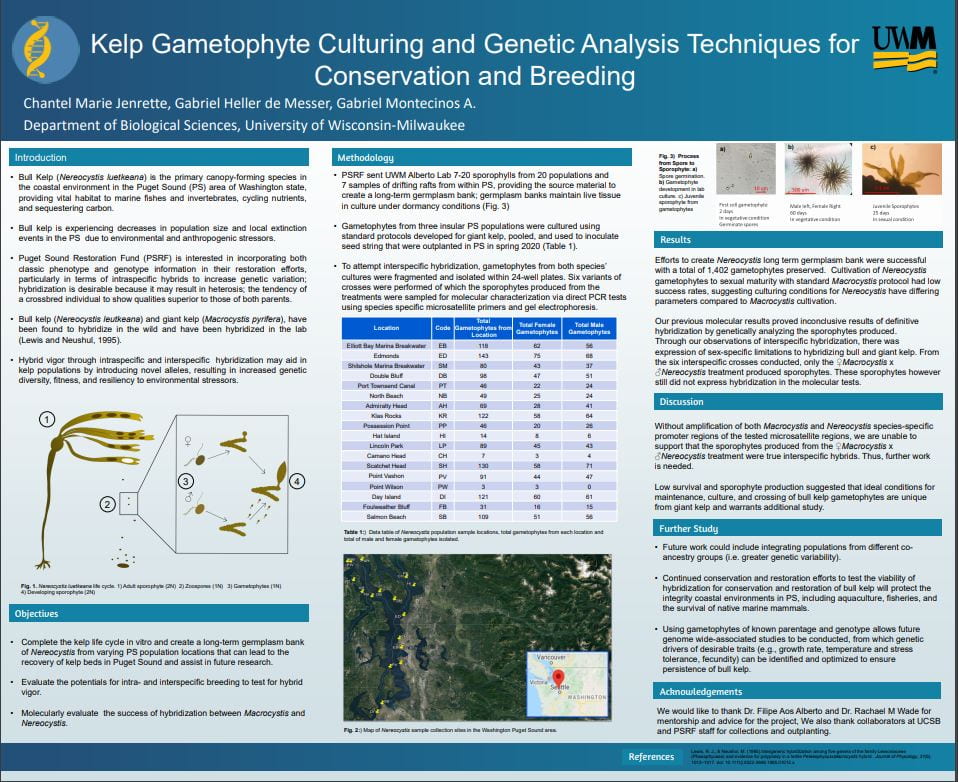Gabriel Heller de Messer & Chantel Jenrette, “Kelp Gametophyte Culturing and Genetic Analysis Techniques for Conservation and Breeding”
Mentors: Filipe Alberto, Gabriel Montecinos & Rachael Wade, Biological Sciences
Bull Kelp (Nereocystis luetkeana) is experiencing decreases in population size and local extinction events in the Puget Sound (PS) area of Washington state due to environmental and anthropogenic stressors. This decrease in resistance and abundance is concerning in PS where Bull Kelp is the primary canopy-forming species in the coastal environment; N. luetkeana provides vital habitat to marine fishes and invertebrates, cycles nutrients, and is an important carbon sink. Puget Sound Restoration Fund (PSRF) works on a multitude of restoration projects, including Bull Kelp. Because of this potential loss of an ecological engineer, PSRF is interested in incorporating both classic phenotype and genotype information in their restoration efforts, particularly in terms of both intra- and interspecific hybrids; hybridization is desirable because it may result in heterosis, or increased fitness and performance afforded by introduction of novel alleles. PSRF sent UWM Alberto Lab 7-20 sporophylls from 20 populations from within PS, providing the source material to create a long-term germplasm bank of 1,600 Bull Kelp gametophytes. Gametophytes from three insular PS populations were cultured using standard protocols developed for Giant Kelp (Macrocystis pyrifera), pooled, and used to inoculate seed string that will ultimately be outplanted in PS in spring 2020. Low survival and sporophyte production suggested that ideal conditions for maintenance, culture, and crossing of Bull Kelp gametophytes are unique from Giant Kelp and warrants additional study. Bull and Giant Kelp gametophytes were reciprocally crossed, produced what appeared to be hybrids, but further work is needed to molecularly confirm the sporophytes were not parthenogenic. Continued efforts to test the viability of hybridization for conservation and restoration of Bull Kelp will protect the integrity coastal environments in PS, including aquaculture, fisheries, and the survival of native marine mammals.
Click the thumbnail below to open the full sized poster in a new tab.


Hello Chantel Jenrette.
I wanted to let you know how much I enjoyed the opportunity to view your poster presentation on Kelp Gametophyte Culturing. I have always found this area of biological sciences to be intriguing. I appreciate how you made sure to define or explain the key concepts throughout your presentation. The content and style of your poster including the use of figures and charts also made the information easier to understand. Your approach to sharing your data was very professional and it clearly demonstrated your understanding of the research that you conducted. Wonderful work!
Thank you for your poster presentation. Although I am not well versed in the topic, I found the poster easy to understand and visually appealing. Concepts were clearly defined and your research process/thinking was reflected in the poster design. Great choice of visual pictures and graphs to support your research. The abstract and poster were professional and demonstrated the depth of your understanding on the topic. Thank you!